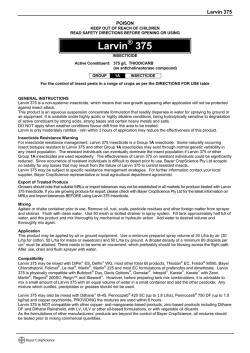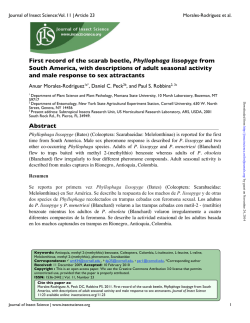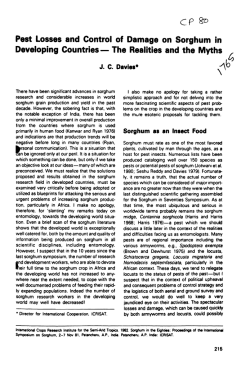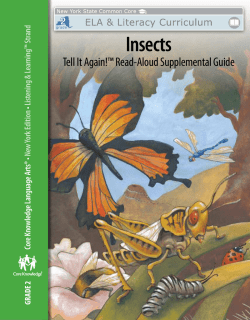
The effect of the insecticide dichlorvos on esterase activity extracted
Wang J-J, Cheng W-X, Ding W, Zhao Z-M. 2004. The effect of the insecticide dichlorvos on esterase activity extracted from the psocids, Liposcelis bostrychophila and L. entomophila. 5pp. Journal of Insect Science, 4:23, Available online: insectscience.org/4.23 Journal of Insect Science insectscience.org The effect of the insecticide dichlorvos on esterase activity extracted from the psocids, Liposcelis bostrychophila and L. entomophila Jin-Jun Wang, Wei-Xia Cheng, Wei Ding, Zhi-Mo Zhao College of Plant Protection, Southwest Agricultural University, Chongqing 400716, People’s Republic of China [email protected] [email protected] Abstract The inhibition kinetics of dichlorvos on carboxylesterase and acetylcholinesterase (AChE) activity extracted from Liposcelis bostrychophila and L. entomophila (Psocoptera: Liposcelididae) were compared. The results showed that L. entomophila had significantly greater specific activity of carboxylesterase than L. bostrychophila (0.045 versus 0.012 µmoles /mg /min). Moreover, the carboxylexterase of L. entomophila showed higher affinity (i.e. lower Km value) to the substrate 1-naphthyl acetate than L. bostrychophila (0.29 versus 0.67 mM). The specific activity and affinity of AChE of the two species were not significantly different. The carboxylesterase of L. bostrychophila was more sensitive to the insecticide dichlorvos than that of L. entomophila. The I50s values of dichlorvos to carboxylesterase for L. bostrychophila and L. entomophila were 1.43 and 3.28 µM, respectively, and to AChE were 324 and 612 nM, respectively. Inhibition kinetics revealed that AChE from L. bostrychophila was 5.8-fold more sensitive to inhibition than AChE from L. entomophila. Keywords: psocid; susceptibility; carboxylesterase, AChE, DDVP Abbreviation: 1-NA 1-naphthyl acetate AChE Acetylcholinesterase ATChI Acetylthiocholine iodide E3 carboxylesterse isozyme (E.C.3.1.1) Introduction The psocids, Liposcelis bostrychophila Badonnel and L. entomophila (Enderlein) are worldwide and commonly found in various processed and unprocessed dry foods in households, granaries, and warehouses (Turner, 1994). Outbreaks of L. bostrychophila, and L. entomophila have been reported in humid tropical countries such as Indonesia, Malaysia, Singapore, The Philippines, Thailand, The People’s Republic of China and India (Wang et al., 1999). Information on the management of psocid pests, however, is very limited (Rees, 1994). Routine fumigations of warehouses and storage facilities with methyl bromide have failed to control these pests (Ho and Winks, 1995). In addition, the rapid development of resistance to chemical and physical treatments by the psocids has also been reported (Santoso et al., 1996; Wang and Zhao, 2003). Metabolic resistance to organophosphorus insecticides has been associated with changes in the activity of carboxylesterases in many insect species (Devonshire and Field, 1991). In two wellstudied cases in which resistance to organophosphorus insecticides is associated with an increase in carboxylesterase activity, sequestration and slow turnover of the phosphate by an overexpressed esterase are responsible for resistance (Devonshire 1977; Karunaratne et al., 1993; Ketterman et al., 1993; Jayawardena et al., 1994). On the other hand, in some insects, resistance to organophosphorus insecticides is associated with the decrease in carboxylesterase activity, such as in the flies, Musca domestica, Lucilia cuprina, and Drosophila melanogaster, where strains resistant to organophosphorus insecticides have high ali-eaterase, low organophosphorus hydrolase, and intermediate malathion carboxylesterase (MCE) activities (Campbell et al., 1997). Acetylcholinesterase (AChE) is a key enzyme that terminates nerve impulses by catalyzing the hydrolysis of the neurotransmitter acetylcholine in the nervous system. Organophosphorous insecticides, such as diazinon, target AChE and irreversibly inhibit the enzyme by phosphorylating a serine hydroxyl group within the enzyme active site. In China, dichlorvos is commonly used to control the insect pests not only in the field but also in stored products. As in the case of other organophosphate insecticides, dichlorvos exerts its effects by inhibiting esterases, especially AChE. In addition, the production of different forms of carboxylesterases is also reported to be the cause of dichlorvos resistance in several insect species. Downloaded from http://jinsectscience.oxfordjournals.org/ by guest on February 6, 2015 Received 17 January 2004, Accepted 10 May 2004, Published 14 July 2004 Wang J-J, Cheng W-X, Ding W, Zhao Z-M. 2004. The effect of the insecticide dichlorvos on esterase activity extracted from the psocids, Liposcelis bostrychophila and L. entomophila. 5pp. Journal of Insect Science, 4:23, Available online: insectscience.org/4.23 As little is known about the mechanisms of insecticide resistance in psocids insects, information on the pesticide biochemistry of Liposcelis esterases will certainly prove valuable in formulating strategies in the control of these rapidly proliferating pests (Leong and Ho, 1995). This study was initiated to understand the kinetics of carboxylesterase and AChE inhibition by dichlorvos of two Liposcelis species. This is an initial step in elucidating the molecular basis of resistance to organophosphorus insecticides in these species. Materials and methods Insects Chemicals and insecticide Acetylthiocholine iodide (ATChI, Sigma, www.sigmaaldrich.com), 5,5’-dithiobis-2-nitrobenzoic acid (DTNB, Sigma, www.sigmaaldrich.com), eserine (Sigma), and 1naphthyl acetate (1-NA) and other biochemical reagents were of reagent grade or better. The insecticide used was 80% dichlorvos (Shalungda Ltd., Changsha, China). Bioassay The efficacy of dichlorvos against the two different liposcelids was determined using the small glass tubes (~6mm x 40mm). Various concentrations of dichlorvos were tested until a satisfactory range (10% - 90% mortality) was ascertained. Six concentrations were used in the final analysis. All the concentrations were diluted with acetone. 30µl of insecticide was pipetted onto the inside of the tubes homogeneously and allowed to dry for 30 min before exposing the insects to it. Each dichlorvos bioassay consisted of 100 adults per concentration and six concentrations (0.36-367 µg/m2). Control groups received acetone alone. Mortality was assessed after 24 h. Psocids that did not move after stimulation from a camel’s hair brush were scored as dead. All tests were run at 25 o C and replicated at least three times on three different days. Mortality data were corrected with Abbott’s (1925) formula and analyzed by probit analysis (Raymond, 1985) to determine the lethal concentrations (LC50). Enzyme preparation For carboxylesterase, fifty female adults were ground in 3 ml of ice-cold 0.04 M, pH 7.0 sodium phosphate buffer in a tissue grinder. The crude homogenates were centrifuged at 10,000g for 15 min at 4 o C. For AChE, fifty female adults were prepared in 3 ml of ice-cold 0.1 M, pH 8.0 phosphate buffer containing 0.1% Triton X-100. The crude homogenates were centrifuged at 20,000g at 4 o C for 60 min. The resulting supernatants were used as the enzyme sources. Carboxylesterase assay Van Asperen’s (1962) method was adapted for the determination of esterase activity. The general buffer was 0.04 M, pH 7.0 phosphate buffer. 1-NA (3 x 10-4M) was used as substrate. In determining the Michaelis constants for 1-NA, the substrate concentrations of 1.5, 3, 6, 15, 30 and 60 mM were made up in phosphate buffer (0.04 M, pH 7.0 ). The mixtures were incubated at 37 o C for 30 min in a water-bath. The reaction was terminated by adding 1 ml of Fast Blue B salt- sodium dodecylsulphate solution. Absorbance was read in the spectrophotometer after 30 min at 600 nm. The kinetic parameters (Km and Vmax) were determined graphically by Lineweaver-Burk plots (Wilkinson, 1961). The in vitro inhibition of carboxylesterase activity was ascertained using 3 x 10-4 M 1-NA as substrate. Concentrations of dichlorvos ranging from 1 x 10-9 M to 1 x 10-3 M in phosphate buffer were tested. Inhibitor (0.1 ml) was added to 5 ml of substrate and the reaction initiated by adding 0.1 ml of enzyme. The relative potency of the inhibitors was investigated by examining their I50 values. Acetylcholinesterase assay AChE activity and its inhibition by dichlorvos were determined according to the method of Ellman et al. (1961) using ATChI as substrate. Briefly, the reaction mixture consisting of ATChI (1.5 mM), DTNB (1 mM) and enzyme preparation (200 µl) was prepared in a final volume of 2.4 ml with phosphate buffer (0.1 M, pH 8.0). The inhibition of dichlorvos was determined by adding various concentrations (from 1 x 10-9 M to 1 x 10-6 M in phosphate buffer) inhibitor (0.1 ml) to the substrate. Absorbance was recorded at 412 nm after 30 min water-bath. Values of Km and Vmax of AChE were determined at 30o C, with 5 ATChI concentrations (ranging from 15 µM to 6.0 mM). The changes of absorbance were observed at 412 nm for 5 min. The bimolecular rate constants (ki = kp/Ka), phosphorylation constant kp and affinity constant Ka, with dichlorvos as inhibitor were determined by pre-incubation of the supernatants with varying inhibitor concentrations. Progressive inhibition of AChE activity over time was continuously recorded for 5 min. The activity of AChE at each 30 second interval was measured for fitting the inhibition curve. The ki value was calculated according to the method of Main (1964). The ki was determined from the gradient of the linear regression: 1 i 't 1 ki 2.303' log v Ka where i is the initial concentration of inhibitor. Values of (∆t / 2.303∆log v) were obtained from a plot of log v against t at constant i. The slope is ki, the intercept on the (1/i) axis is (-1/Ka), and the intercept on the (∆t / 2.303∆log v) axis is (1/kp). Assays of protein contents Protein contents of the enzyme homogenate were Downloaded from http://jinsectscience.oxfordjournals.org/ by guest on February 6, 2015 Stock colonies of L. bostrychophila and L. entomophila were started with nymphs collected from a wheat warehouse in Chongqing, the People’s Republic of China in 1990. The colonies were maintained on an artificial diet consisting of whole wheat flour, skim milk and yeast powder (10:1:1) in a room maintained at 28±1 o Cand a scotoperiod of 24 h. Cultures were set up in glass bottles (250 ml) with a nylon screen cover and kept in desiccators (5 liter), in which the humidity was controlled with saturated NaCl solution at 75-80%. After several generations, insects from the stock colonies were used for the tests. All experiments were conducted under the conditions described above with 2- to 5-day old female adults. 2 Wang J-J, Cheng W-X, Ding W, Zhao Z-M. 2004. The effect of the insecticide dichlorvos on esterase activity extracted from the psocids, Liposcelis bostrychophila and L. entomophila. 5pp. Journal of Insect Science, 4:23, Available online: insectscience.org/4.23 determined according to the method of Bradford (1976) using bovine serum albumin as standard. The measurement was performed with the spectrophotometer at 595 nm. Results Bioassays The exposure concentrations of dichlorvos required obtaining LC50 values for L. bostrychophila and L. entomophila adults are summarized in Tables 1. The data show that L. bostrychophila is more tolerant of dichlorvos than L. entomophila based on LC50 values. However, the difference of tolerance between two species is not significant considering the 95% confidence limit (P > 0.05). Activity of AChE A strong linear relationship between homogenate concentrations and AChE activities for both L. bostrychophila (R2 = 0.998) and L. entomophila (R2 = 0.997) was obtained. Homogenate concentrations of 4.8 and 6.4 insects per assay were in the middle portion of the linear regression and so 5 insects per assay were used throughout this study. There was no significant difference (P > 0.05) between the affinities (Km) of the AChE from either Liposcelis spp. The catalytic activities (Vmax) of AChE toward ATChI were also similar. This implies that similar degrees of substrate protection was afforded in both species in the inhibition studies. The activity of AChE per insect in L. entomophila was significantly higher than that of L. bostrychophila, but the specific activity (nanomoles/min) from both species was similar. The protein content differed in both insects (P < 0.05) (Table 3). The effects of dichlorvos on AChE activity are shown in Fig. 1B. The inhibition of enzyme activity was between 10% and 90%. The efficiencies of the AChE inhibitors were compared based on their I50s. Liposcelis bostrychophila AChE was more sensitive to the inhibitory action of dichlorvos than that of L. entomophila. Table 4 shows estimates of the kinetic constants, Ka, kp and ki (kp/Ka) for the reaction between AChE and the organophosphorus insecticide, dichlorvos. The ki values of L. bostrychophila and L. entomophila are 0.015 and 0.0026 nM-1min1 , respectively, indicating that dichlorvos is a more potent inhibitor of the AChE for L. bostrychophila than for L. entomophila, largely due to a 4.16-fold lower Ka. kp did not differ significantly between the two pests. The susceptibility tendency is similar with the inhibition results of the specific activity for esterase. Discussion In the survey of possible interactions between insecticides and carboxylesterase from Aphis gossypii, Owusu (1996) found significant inhibition of the enzyme by a number of organophosphates Table 1. The toxicity of DDVP to Liposcelis bostrychophila and L. entomophila. Insects Slope±SE L. bostrychophila L. entomophila 1.1±0.2 0.9±0.1 LC50 (µg/m2) (95%CLa) 2b 54.4 (73.1~35.7) 45.3 (62.0~28.7) 2.7 2.4 a. 95% confidence limit. LC50 is considered significantly different when the 95% CI fail to overlap. b. Chi-square goodness-of-fit test. Table 2. Carboxylesterase activity in Liposcelis bostrychophila and L. entomophila. Insects Protein (µg / insect) nmoles / min/ insect µmoles / min/mg L. bostrychophila L. entomophila Ratio 37.4±0.3a 66.1±0.6b 1.8 0.47±0.04a 2.99±0.05b 6.4 0.012±0.005a 0.045±0.006b 3.8 Within the same row, means followed by the different letters are significantly different (P < 0.05). Table 3. AChE activity in Liposcelis bostrychophila and L. entomophila. Insects Protein (µg/insect) nanomoles/min L. bostrychophila L. entomophila 25. 2±0.7a 35.9±0.8b 24.5±0.5a 25.2±0.7a Within the same row, means followed by the different letters are significantly different (P < 0.05). Table 4. Affinity constant (Ka), phosphorylation rate constant (kp) and bimolecular rate constant (ki) of L. bostrychophila and L. entomophila. Insecticide DDVP Insects Ki (nM-1min-1) Ka ( nM) kp (min-1) L. bostrychophila L. entomophila 0.015±0.002 0.0026±0.0004 1.80±0.36 7.48±1.34 0.027±0.009 0.019±0.006 Downloaded from http://jinsectscience.oxfordjournals.org/ by guest on February 6, 2015 Activities of carboxylesterase There was a strong linear relationship between homogenate concentrations and carboxylesterase activity for both L. bostrychophila (R2 = 0.998) and L. entomophila (R2 = 0.999). Homogenate concentrations of 5 and 1.67 insects equivalents per assay were in the middle portion of the linear regression and were used throughout this study. L. bostrychophila and L. entomophila differed significantly in the amount of protein per individual. It averaged 37.4 and 66.1µg/ insect for L. bostrychophila and L. entomophila, respectively (Table 2). Carboxylesterase from L. entomophila showed a significantly higher affinity (i.e. lower Km value) to the substrate 1NA than that of L. bostrychophila (P < 0.05). In contrast, the catalytic activity of 1-NA towards carboxylesterase in L. entomophila was higher (i.e. higher Vmax value) than that in L. bostrychophila (Table 4). The higher activity of L. entomophila esterase towards 1-NA than that of L. bostrychophila is observed (Table 2). The relative susceptibility of the esterase from the two liposcelids to dichlorvos is shown in Fig 1A. Based on the I50 values (the concentration required to inhibit 50% of esterase activity), L. bostrychophila esterase (1.43 µM) showed higher susceptibility to dichlorvos than L. entomophila (3.28 µM). Inhibition kinetics of carboxylesterase indicated that the inhibition type of dichlorvos were competitive for both L. bostrychophila and L. entomophila. 3 Wang J-J, Cheng W-X, Ding W, Zhao Z-M. 2004. The effect of the insecticide dichlorvos on esterase activity extracted from the psocids, Liposcelis bostrychophila and L. entomophila. 5pp. Journal of Insect Science, 4:23, Available online: insectscience.org/4.23 4 Liposcelis bostrychophila (solid line and dots) and L. entomophila (dotted line and circles) in relation to the applied dichlorvos concentrations. Acknowledgements This research was funded in part by the National Natural Sciences Foundation (39800017) and Fok Ying-Tung Educational Foundation (71022) of P. R. China to Jin-Jun Wang. and carbamates. Theoretically, the kinetics involved in such inhibition trends based on a Michaelis intermediate reaction mechanism (Aldridge and Reiner, 1972), in which an enzyme and an inhibitor combine to form enzyme-inhibitor complex. The production of different isozymes of carboxylesterase is reported to be the cause of dichlorvos resistance in the cotton aphid, A. gossipii (Glover). By isoelectric focusing technique O’Brien et al. (1992) also showed the involvement of different bands in organophosphate resistance of A. gossipii on cotton in the United States. However, the role of such isozymes in resistance of this aphid has not yet been clarified. In the green peach aphid, Myzus persicae (Sulzer), insecticide hydrolysis by an E4 isozyme in resistant aphids is the cause of organophosphate resistance (Devonshire and Moores, 1982). For psocids, Leong and Ho (1995) reported that a qualitatively good correlation between the results obtained from the in vitro carboxylesterase assays and electrophoretic analysis, showing a References Abbott WS. 1925. A method of computing the effectiveness of an insecticide. Journal of Economic Entomology 18: 265–267. Aldridge W N, Reiner E. 1972. Enzyme inhibitors as substrates. vol. 26. North-Holland, Amsterdam. Bradford MM. 1976. A rapid and sensitive method for the quantification of microgram quantities of protein utilizing the principle of protein-dry binding. Analytical Biochemistry 72: 248-254. Campbell PM, Trott JF, Claudianos C, Smyth K, Russell RJ, Oakeshott JG.. 1997. Biochemistry of esterases associated with organophosphate resistance in Lucilia cuprina with comparisons to putative orthologues in other diptera. Biochemical Genetics 35: 17-40. Downloaded from http://jinsectscience.oxfordjournals.org/ by guest on February 6, 2015 Figure 1. Percent inhibition of carboxylesterase activity (A) and AChE (B) in higher esterase sensitivity to inhibition in L. bostrychophila than in L. entomophila. The similar result was also obtained in the present study. However, based on the bioassay, L. bostrychophila is more tolerant to dichlorvos than L. entomophila. This may be due to the sensitive esterase of L. bostrychophila that may preferentially bind dichlorvos, thereby protecting AChE, resulting in greater tolerance to dichlorvos. Acetylcholinesterase is of interest because it is the targetsite for organophosphate and carbamate insecticides in the central nervous system, and its role in cholinergic synapses is essential for life (Fournier and Mutero, 1994). Based on the values of I50s (the concentration required to inhibit 50% of AChE activity) and ki (bimolecular rate constants for AChE inhibition), L. bostrychophila’s AChE was more sensitive to the inhibitory action of dichlorvos than that of L. entomophila. In contrast, Leong and Ho (1995) reported that dichlorvos is a more potent inhibitor of AchE in L. entomophila than in L. bostrychophila. They also found that L. entomophila is more tolerant of dichlorvos than L. bostrychophila based on bioassay data. The difference might be due to the different geographic population used. Price (1988) pointed out that the sensitivity of AChE does not necessarily mean that insects will be susceptible to the particular chemical when it is used as an insecticide as toxicity of a particular compound depends on many factors including cuticle penetration and metabolic processes (Matsumura, 1985; Hassall, 1990). This suggests that the higher sensitivity of L. bostrychophila AChE to inhibition implies that the underlying mechanism of tolerance in insecticide bioassays in the this species is largely due to metabolic activities which either detoxify or limit the intoxicating ability of dichlorvos. The present study has provided some basic information on the esterases of these two psocids that will be useful to understand the mechanisms of insecticide resistance in the psocids. As strains of liposcelid psocids that exhibit varying tolerance to insecticides become available they will be useful for further comparative toxicology and biochemical studies. Wang J-J, Cheng W-X, Ding W, Zhao Z-M. 2004. The effect of the insecticide dichlorvos on esterase activity extracted from the psocids, Liposcelis bostrychophila and L. entomophila. 5pp. Journal of Insect Science, 4:23, Available online: insectscience.org/4.23 Main AR. 1964. Affinity and phosphorylation constants for the inhibition of esterases by organophosphates. Science 803: 324-332. Matsumura F. 1985. Toxicology of Insecticides. 2nd ed., 598pp. Plenum Press, New York. O’Brien PJ, Abdel-Aal YA, Ottea JA, Graves JB. 1992. Relationship of insecticide resistance to carboxylesterase in Aphis gossypii Glover (Homoptera: Aphididae) from mid south cotton. Journal of Economic Entomology 85: 651-657. Owusu EO, Horiike M, Hirano C. 1996. Polyacrylamide gel electrophoretic assessments of esterase in cotton aphid (Homoptera: Aphididae) resistance to dichlorvos. Journal of Economic Entomology 89: 302-306. Price NR. 1988. Insecticide-insensitive acetylcholinesterase from a laboratory selected and field strain of housefly (Musca domesiica). Comparative Biochemistry and Physiology 90C: 221-224. Raymond M. 1985. Presentation d’un programme basic d’analyse log-probit pour micro-ordinateur. Cahiers ORSTOM: Serie Entomologie Medicale et Parasitologie 23: 117–121. Rees DP. 1994. Tiny insects become big problem. Stored Grain Australia, June 1994, 1 and 5. Santoso T, Dharmaputra OS, Halid H, Hodges RJ. 1996. Pest management of psocids in milled rice stores in the humid tropics. International Journal of Pest Management 42: 189– 197. Turner BD. 1994. Liposcelis bostrychophila (Psocoptera; Liposcelididae), a stored food pest in the UK. International Journal of Pest Management 40: 179-190. Van Asperen K. 1962. A study of house fly esterase by means of a sensitive colorimetric method. Journal of Insect Physiology 8: 401-416. Wang JJ, Zhao ZM, Li LS. 1999. Induced tolerance of the psocid, Liposcelis bostrychophila (Psocoptera: Liposcelididae) to controlled atmosphere. International Journal of Pest Management 45: 75-79. Wang JJ, Zhao ZM. 2003. Accumulation and utilization of triacylglycerol and polysaccharides in Liposcelis bostrychophila (Psocoptera, Liposcelididae) selected for resistance to carbon dioxide. Journal of Applied Entomology 127: 107-117. Wilkinson G.N. 1961. Statistical estimation in enzyme kinetics. Biochemical Journal 803: 324-332. Downloaded from http://jinsectscience.oxfordjournals.org/ by guest on February 6, 2015 Devonshire AL. 1977. The properties of a carboxylesterase from the peach-potato aphid, Myzus persicae (Sulz.), and its role in conferring insecticide resistance. Biochemical Journal 167: 675-683. Devonshire AL, Moores GD. 1982. A carboxylesterase with broad substrate specificity causes organophosphorus, carbamate and pyrethroid resistance in peach-potato aphid(Myzus persicae). Pesticide Biochemistry and Physiology 18: 235246. Devonshire AL, Field LM. 1991. Gene amplification and insecticide resistance. Annual Review of Entomology 36: 1-23. Ellman GL, Courtney KD, Andres V, Featherstone RM. 1961. A new and rapid colorimetric determination of acetylcholinesterases activity. Biochemical Pharmacology 7: 88-95. Fournier D, Mutero A. 1994. Modification of acetylcholinesterase as a mechanisms of resistance to insecticides. Comparative Biochemistry and Physiology 108C: 19-31. Hassall KA. 1990. The biochemistry and use of pesticides. Structure, metabolism, mode of action and use in crop protection. 2nd ed. 536pp, MacMillan, NewYork. Ho SH, Winks RG.. 1995. The response of Liposcelis bostrychophila Badonnel and L. entomophila (Enderlein) (Psocoptera) to phosphine. Journal of Stored Products Research 31: 191197. Jayawardena KGI, Karunaratne SHPP, Ketterman AJ, Hemingway J. 1994. Determination of the role of elevated B2 esterase in insecticide resistance in Culex quinquefasciatus (Diptera: Culicidae) from studies on the purified enzyme. Bulletin of Entomological Research 84: 39-44. Karunaratne SHPP, Jayawardena KGI, Hemingway J, Ketterman AJ. 1993. Characterisation of a B-type esterase involved in insecticide resistance from the mosquito Culex quinquefasciatus. Biochemical Journal 294: 575-579. Ketterman AJ, Karunararne SHPP, Jayawardena KGI. 1993. Qualitative differences between populations of Culex quinquefasciatus in both the esterases A2 and B2 which are involved in insecticide resistance. Pesticide Biochemistry and Physiology 47: 142-148. Leong ECW, Ho SH 1995. In vitro inhibition of esterase activity in Liposcelis bostrychophila Bad. and L. entomophila (End.) (Psocoptera: Liposcelididae). Comparative Biochemistry and Physiology 110B: 121-130. 5
© Copyright 2025



